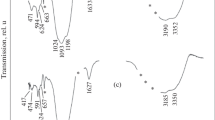Abstract
The reactivities of the binary and ternary mixtures of reactive magnesia (MgO≡M), hydratable alumina (Al2O3≡A) and microsilica (SiO2≡S) micropowders were investigated by calorimetric method and other analytical techniques (X-ray diffraction (XRD), Fourier transform infrared spectroscopy (FT-IR), differential thermal/thermogravimetric (DTA-TG) analysis and scanning electron microscope (SEM) observations). Effect of water/solid mass ratio and temperature on the hydration behavior of the M–A, M–A–S, M–S, A–M–S and A–S hydratable binders were established. The methodological considerations on both in situ and ex situ mixing techniques have also been taken. The initial mixing peak was due to wetting of the binder particles and initial dissolution reactions. A second, extensive heat peak was associated with the formation of crystalline and noncrystalline hydration products, i.e., brucite Mg(OH)2, magnesium aluminate hydrate (MAH; H≡H2O)-like phase, magnesium silicate hydrate (MSH)-like phase and magnesium aluminum silicate hydrate gels (MASH). Negligible heat was evolved during the hydration reaction of A–S mixture, and the second reaction peak was not observed. Nevertheless, the presence of Al2O3 and SiO2 in other combinations contributes to the consumption of Mg(OH)2 which was formed during the initial stages of hydration and leads to the formation of cementitious products, like M–A–H, M–S–H and M–A–S–H.









Similar content being viewed by others
References
Pacewska B, Nowacka M, Antonovič V, Aleknevičius. Investigation of early hydration of high aluminate cement-based binder at different ambient temperatures. J Therm Anal Calorim. 2012;109:717–26.
Pacewska B, Nowacka M. Studies of conversion progress of calcium aluminate cement hydrates by thermal analysis method. J Therm Anal Calorim. 2014;117:653–60.
Singh VK. High-alumina refractory castables with calcium aluminate binder. J Mater Sci Lett. 1989;8:424–6.
Obradović N, Terzić A, PavlovićLj Filipović S, Pavlović V. Dehydration investigations of a refractory concrete using DTA method. J Therm Anal Calorim. 2012;110(1):37–41.
Sawków J, Nocuń-Wczelik W. Calorimetric studies of refractory corundum. Calcium aluminate composites. J Therm Anal Calorim. 2003;74:451–8.
Sakai E, Sugiyama T, Saito T, Daimon M. Mechanical properties and micro-structures of calcium aluminate based ultra high strength cement. Cement Concrete Res. 2010;40(6):966–70.
Silva AP, Segadães AM, Pinto DG, Oliveira LA, Devezas TC. Effect of particle size distribution and calcium aluminate cement on the rheological behaviour of all-alumina refractory castables. Powder Technol. 2012;226:107–13.
Ukrainczyk N, Matusinović T. Thermal properties of hydrating calcium aluminate cement pastes. Cement Concrete Res. 2010;40:128–36.
Das SK, Mitra A, Das Poddar PK. Thermal analysis of hydrated calcium aluminates. J Therm Anal. 1996;47:765–74.
Da Luz AP, Braulio MAL, Pandolfelli VC. Refractory castable engineering. F.I.R.E. Compendium Series. Baden-Baden: Göller Verlag GmbH; 2015.
Azizian F. Improving the performances of cement-free castables. Ceram Ind. 1997;147(2):42–8.
Poddar DD, Mulkhopadhyay S. Spinel-bonded basic castables in relation to spinel formation agents. Inteceram. 2002;51(4):282–8.
Ye G, Troczynski T. Hydration of hydratable alumina in the presence of various forms of MgO. Ceram Int. 2006;32(3):257–62.
Ye G, Troczynski T. Effect of magnesia on strength of hydratable alumina-bonded castable refractories. J Mater Sci. 2005;40:3921–6.
Szczerba J, Prorok R, Śnieżek E, Madej D, Maślona K. Influence of time and temperature on ageing and phases synthesis in the MgO–SiO2–H2O system. Thermochim Acta. 2013;567:57–64.
Li Z, Zhang T, Hu J, Tang Y, Niu Y, Wei J, Yu Q. Characterization of reaction products and reaction process of MgO–SiO2–H2O system at room temperature. Constr Build Mater. 2014;61:252–9.
Nied D, Enemark-Rasmussen K, L’Hopital E, Skibsted J, Lothenbach B. Properties of magnesium silicate hydrates (M–S–H). Cement Concrete Res. 2016;79:323–32.
Ma W, Brown PW. Mechanisms of reaction of hydratable aluminas. J Am CeramSoc. 1999;82(2):453–6.
Sako EY, Braulio MAL, Zinngrebe E, Van der Laan SR, Pandolfelli VC. Fundamentals and applications on in situ spinel formation mechanisms in Al2O3–MgO refractory castables. Ceram Int. 2012;38:2243–51.
Zhang T, Vandeperre LJ, Cheeseman CR. Formation of magnesium silicate hydrate (M–S–H) cement pastes using sodium hexametaphosphate. Cement Concrete Res. 2014;65:8–14.
ICDD PDF-2 database product.
Miller A, Wilkins CH. Infrared spectra and characteristic frequencies of inorganic ions. Anal Chem. 1952;24:1253–94.
Zhang Z, Zheng Y, Ni Y, Liu Z, Chen J, Liang X. Temperature- and pH-dependent morphology and FT-IR analysis of magnesium carbonate hydrates. J Phys Chem B. 2006;110:12969–73.
Yu P, Kirkpatrick RJ, Poe B, McMillan PF, Cong X. Structure of calcium silicate hydrate (C–S–H): near-, mid-, and far-infrared spectroscopy. J Am Ceram Soc. 1999;82:742–8.
Tarte P. Infra-red spectra of inorganic aluminates and characteristic vibrational frequencies of AlO4tetrahedra and AlO6 octahedra. Spectrochim Acta A Mol Spectrosc. 1967;23(7):2127–43.
Hanna R. Infrared properties of magnesium oxide. J Am Ceram Soc. 1965;48(7):376–80.
Frost RL, Kloprogge JT. Infrared emission spectroscopic study of brucite. Spectrochim Acta A. 1999;55:2195–202.
Acknowledgements
The research was performed at Faculty of Materials Science and Ceramics of AGH within the confines of the project no 11.11.160.617. The authors thank TA Instruments company for microcalorimetric measurement.
Author information
Authors and Affiliations
Corresponding author
Rights and permissions
About this article
Cite this article
Madej, D., Ortmann, C., Szczerba, J. et al. Calorimetry and other methods in the studies of reactive magnesia–hydratable alumina–microsilica hydrating mixtures. J Therm Anal Calorim 126, 1133–1142 (2016). https://doi.org/10.1007/s10973-016-5634-0
Received:
Accepted:
Published:
Issue Date:
DOI: https://doi.org/10.1007/s10973-016-5634-0




